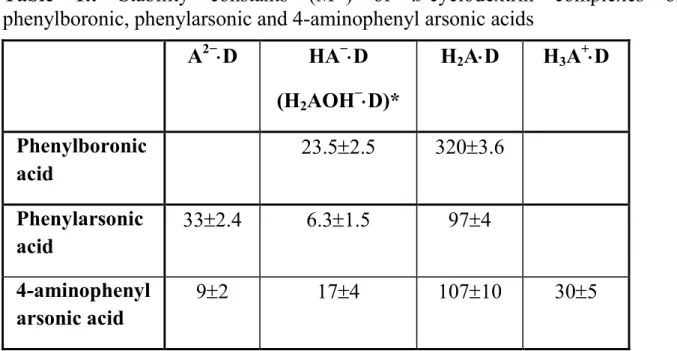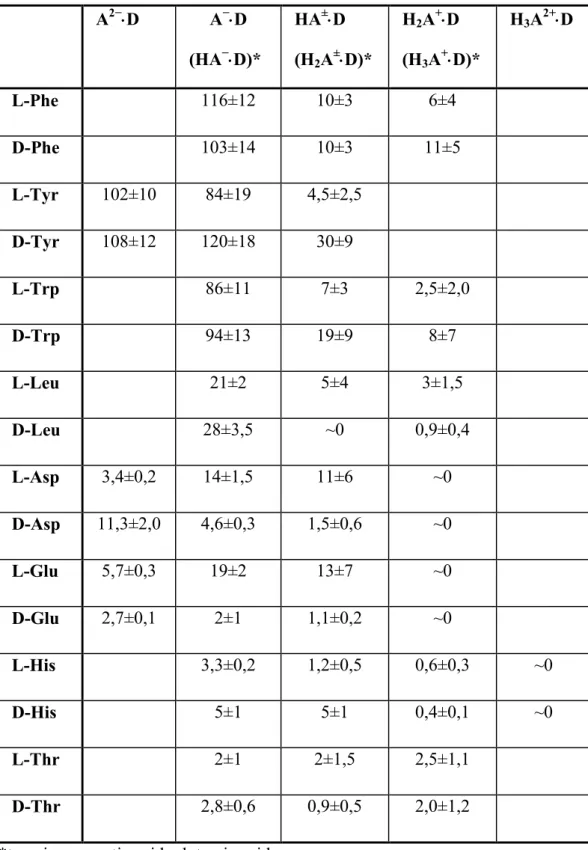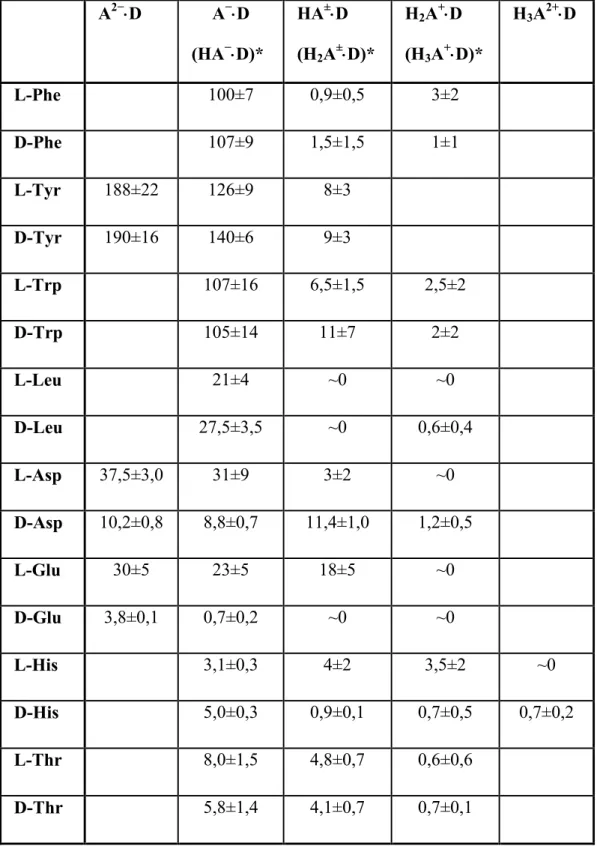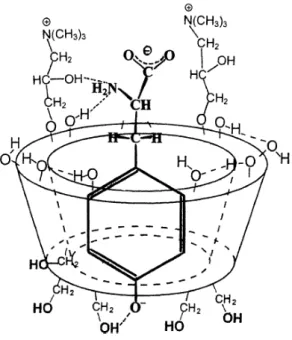The inclusion complex formation of unsubstituted and ionic cyclodextrins with amino acids and phenyl
derivatives of inorganic oxoacids
Ph.D. Thesis
Zita Sebestyén
Semmelweis University
School of Ph. D. Studies of Pharmaceutical Sciences
Supervisor: Dr. Ágnes Buvári-Barcza C. Sc.
Opponents: Dr. Hilda Kőszegi-Szalai PhD.
Prof. Dr. Éva Szökő pharm. habil., D. Sc.
Theoretical Committee:
Prof. Dr. Éva Lemberkovics C. Sc.
Dr. Ilona Török C. Sc.
Prof. Dr. Krisztina Novák-Takács D. Sc.
Budapest 2011
1
Introduction
The inclusion complexes are supramolecular assemblies composed by two or more molecules. The host-guest complexes are held together without covalent bonds. From the point of view of the formation of inclusion complexes the size and the structure of the guest are predominant. The fit of the guest in the cavity should be appropriate to form van der Waals and hydrophobic interactions and hydrogen bonding. A special type of these process is the complex formation of cyclodextrins.
The inclusion complexes of cyclodextrins have wide application because the physical and chemical properties of the guest compounds are changed on the effects of complex formation. For example the pharmaceutical application of cyclodextrins is remarkable: the solubility and the stability of the active ingredients and the permeability of biological membranes can be improved without any changes in the chemical quality of the compound.
The preparation of pure enantiomers is required not only in the pharmaceutical industry. The verification of the optical purity is a big challenge of the analytical chemistry. The cyclodextrins can interact differently with enantiomers. The synthesis of new derivatives enriches the possibility of analytical applications.
The synthesis and preparation of new cyclodextrin derivatives are continuously in the industrial research because of their pharmaceutical application and their role in separation sciences. In the past decade several ionizable and permanently ionic derivatives have been synthesized, providing modified complexing abilities. If the host or the guest molecules have a charge, electrostatic interactions gain increased importance.
2
The ionization state of guest molecules with acid-base properties is also of crucial importance in the stability of complexes. Their ionization state and complex forming ability depend on the pH of the dissolution media.
Research Objectives
In the present work, the role of charges in the inclusion complex formation of ß-cyclodextrin and its ionic derivative ((2-hydroxy-3-N,N,N- trimethylammonium)propyl-ß-cyclodextrin chloride) has been investigated in terms of electrostatic interactions, hydrogen bonding and steric effects between the host and the guest molecules. Cyclodextrins were obtained from Cyclolab Ltd. (Hungary) as a gift within the framework of a research collaboration.
Two different groups of compounds were chosen as guest molecules for the investigation: phenyl derivatives of inorganic oxoacids and L- and D- enantiomers of amino acids. The latter is especially interesting from the point of view of the applications in biological systems.
In the case of the first group of the guest molecules not only the role of the benzene ring, but also the effect of the inorganic acidic groups can be investigated in different ionization states. The substituent of 4-aminophenyl arsonic acid provides facilities to investigate the effect of substitution and ionization in the same time.
In the case of amino acids the stability of the associates can be the result of various effects: the hydrophobic part can enter the cavity, while the hydrated amino acid moiety remains outside of the ring and can take part in electrostatic and hydrogen bonding interactions, depending on the different ionization states according to the pH of the solution. On the other hand, the enantiomers of these compounds permit of the investigation of chiral recognition.
Our aim was also the investigation of the structure of some amino acid – cyclodextrin complex, which has higher stability constant.
3
Methods
Potentiometric method
The titration was performed with a Radiometer VIT90 type video titrator fitted with a Radiometer pHC2701-7 combined glass electrode and a Radiometer ABU93 type automatic burette. The solutions were thermostatted at 25 ± 0.1 °C during the titrations, under stirring with nitrogen.
In the case of the phenyl derivatives of inorganic oxoacids aliquots of 5·10−3 – 2 ·10−2 M solutions of the acids were titrated with 0.2 M carbonate free NaOH solution in the absence and in the presence of 5·10−3–1.4·10−2 M ß−cyclodextrin. The ionic strength was adjusted to 0.2 M by the addition of NaCl. The system was calibrated by the titration of 20.00 cm3 0.02 M HCl (0.18 M in NaCl) solution with 0.2 M NaOH.
In the case of the amino acids aliquots of 1.8·10−2 –1.0·10−1 M solutions of the salts of amino acids (prepared in solution from weighed amounts of the acids by the addition of calculated amounts of NaOH) were titrated with 0.25 M
HCl solution in the absence and in the presence of 0.01 M ß-cyclodextrin or 0.01–0.025 M quaternary ammonium ß-cyclodextrin. The ionic strength was adjusted to 0.25 M by the addition of NaCl. This system was calibrated using two different buffers (pH 2.05 and 7.07) and checked using a third buffer (pH 9.27).
Spectrophotometric methods
Spectrophotometry measurements were carried out with Spectromom 195D and Camspec M330 instruments, in 10 mm cells. The solutions were thermostatted at 25 ± 0.5 °C.
4
In alkaline medium phenolphthalein was used as indicator in a concentration of 3·10−5 M. The pH was adjusted with 0.02 M Na2CO3. The ionic strength was adjusted to 0.25 M by the addition of NaCl. The concentration of ß-cyclodextrin varied stepwise from 0 to 2.4·10−4 M and that of the salts of the acids (freshly prepared the same way as for the potentiometric method) from 0 M to 6·10−2 M. The absorbances were measured at λ = 550 nm.
The complex formation of the acidic forms was studied in 0.1 M HCl solutions with methyl orange as indicator, at wavelengths of 506 nm and 319 nm. The concentrations were as follows: methyl orange: 2·10−5 M, ß-cyclodextrin: 0 – 9·10−3 M and the acids: 0–2·10−2 M.
1H and 13C NMR spectroscopy
Appropriate amounts of L-phenylalanine, L-tyrosine and the dried cyclodextrins were weighed and dissolved in D2O. The final concentrations were as follows: ß-cyclodextrin: 0.01 M, quaternary ammonium ß-cyclodextrin:
0.05 M, phenylalanine: 0.01–0.04 M and 0.025–0.1 M, respectively, so the molar ratios in the mixtures: 0:1; 1:1; 2:1; 4:1; 1:0 in the case of ß-cyclodextrin and 0:1; 0,5:1; 1:1; 2:1; 1:0 with quaternary ammonium ß-cyclodextrin.
The spectra have been recorded in neutral solutions and in the presence of 0.02 M Na2CO3 as well, on a Bruker DRX 500 NMR spectrometer. The temperature was kept constant at 300 ± 0.1 K.
5
Results
1. Investigation of phenyl derivatives of inorganic oxoacids
The stability constants of ß-cyclodextrin complexes of phenylboronic, phenylarsonic and 4-aminophenyl arsonic acids are collected in Table 1., in different ionization states.
Table 1.: Stability constants (M-1) of ß-cyclodextrin complexes of phenylboronic, phenylarsonic and 4-aminophenyl arsonic acids
A2−⋅⋅⋅⋅D HA−⋅⋅⋅⋅D (H2AOH−⋅⋅⋅⋅D)*
H2A⋅⋅⋅⋅D H3A+⋅⋅⋅⋅D
Phenylboronic acid
23.5±2.5 320±3.6
Phenylarsonic acid
33±2.4 6.3±1.5 97±4
4-aminophenyl arsonic acid
9±2 17±4 107±10 30±5
2. Investigation of the complexes of alpha-amino acids
The investigated amino acids can be classified into three types. (The stability constants of ß-cyclodextrin complexes of the amino acids are collected in Table 2.) The highest stability constants have been obtained for phenylalanine, tyrosine and tryptophan, in accordance with the expectations: the presence of the aromatic side group is especially favourable for the complex formation. The complexes of leucine have also a considerable stability in the middle range. The lowest stabilities are found for the smallest or most hydrophilic compounds as threonine, and aspartic acid, glutamic acid and histidine.
6
Table 2.: Stability constants (M-1) of the ß-cyclodextrin complexesof the amino acids obtained from the potentiometric measurements
A2−⋅⋅⋅⋅D A−⋅⋅⋅⋅D (HA−⋅⋅⋅⋅D)*
HA±⋅⋅⋅⋅D (H2A±⋅⋅⋅⋅D)*
H2A+⋅⋅⋅⋅D (H3A+⋅⋅⋅⋅D)*
H3A2+⋅⋅⋅⋅D
L-Phe 116±12 10±3 6±4
D-Phe 103±14 10±3 11±5
L-Tyr 102±10 84±19 4,5±2,5 D-Tyr 108±12 120±18 30±9
L-Trp 86±11 7±3 2,5±2,0
D-Trp 94±13 19±9 8±7
L-Leu 21±2 5±4 3±1,5
D-Leu 28±3,5 ~0 0,9±0,4
L-Asp 3,4±0,2 14±1,5 11±6 ~0 D-Asp 11,3±2,0 4,6±0,3 1,5±0,6 ~0 L-Glu 5,7±0,3 19±2 13±7 ~0 D-Glu 2,7±0,1 2±1 1,1±0,2 ~0
L-His 3,3±0,2 1,2±0,5 0,6±0,3 ~0
D-His 5±1 5±1 0,4±0,1 ~0
L-Thr 2±1 2±1,5 2,5±1,1
D-Thr 2,8±0,6 0,9±0,5 2,0±1,2
*tyrosine, aspartic acid, glutamic acid
7
The most remarkable fact looking at the results obtained for the aromatic group is that the complex stability constants of the apparently uncharged forms and ß-cyclodextrin are surprisingly low compared to those of other aromatic compounds for example phenyl derivatives of inorganic oxoacid. On the other hand, the formation constants for the anionic complexes are much higher than those of other aromatic anions. This is opposite to the general trends of ß-cyclodextrin complexes.
The complexes of the completely protonated forms are characterized by very low stability constants, which is in line with the common trends.
In most cases there is no remarkable difference between the complex formation with unsubstituted ß-cyclodextrin and quaternary ammonium ß-cyclodextrin, although a strong electrostatic interaction, increasing the stability might be expected with anionic guests. (The stability constants of quaternary ammonium ß-cyclodextrin complexes of the amino acids are collected in Table 3.) A significant increase of the stability constants as compared to the native ß-cyclodextrin has been found only in the case of the anionic forms of tyrosine, L-aspartic acid and L-glutamic acid with quaternary ammonium ß-cyclodextrin. This can be understood considering that in these cases hydrogen bonding is possible with both rims of the cyclodextrin, in addition to the increased electrostatic attraction. This effect can overcompensate the steric hindrance of the substituents, resulting in deeper penetration of the guest molecule. It is not surprising that quaternary ammonium ß-cyclodextrin forms less stable complexes with the zwitterionic or cationic forms: the presence of positive charges on the guest is electrostatically unfavourable.
8
Table 3.: Stability constants (M-1) of the quaternary ammonium ß-cyclodextrin complexes of the amino acids obtained from the potentiometric measurements
A2−⋅⋅⋅⋅D A−⋅⋅⋅⋅D (HA−⋅⋅⋅⋅D)*
HA±⋅⋅⋅⋅D (H2A±⋅⋅⋅⋅D)*
H2A+⋅⋅⋅⋅D (H3A+⋅⋅⋅⋅D)*
H3A2+⋅⋅⋅⋅D
L-Phe 100±7 0,9±0,5 3±2
D-Phe 107±9 1,5±1,5 1±1
L-Tyr 188±22 126±9 8±3 D-Tyr 190±16 140±6 9±3
L-Trp 107±16 6,5±1,5 2,5±2
D-Trp 105±14 11±7 2±2
L-Leu 21±4 ~0 ~0
D-Leu 27,5±3,5 ~0 0,6±0,4
L-Asp 37,5±3,0 31±9 3±2 ~0 D-Asp 10,2±0,8 8,8±0,7 11,4±1,0 1,2±0,5
L-Glu 30±5 23±5 18±5 ~0
D-Glu 3,8±0,1 0,7±0,2 ~0 ~0
L-His 3,1±0,3 4±2 3,5±2 ~0
D-His 5,0±0,3 0,9±0,1 0,7±0,5 0,7±0,2 L-Thr 8,0±1,5 4,8±0,7 0,6±0,6
D-Thr 5,8±1,4 4,1±0,7 0,7±0,1
*tyrosine, aspartic acid, glutamic acid
9
3. Results of 1H and 13C NMR experiments
The most remarkable changes in the 1H spectra recorded in neutral solutions are the upfield shifts of H3 (4.02–3.94 ppm) and H5 (3.94–3.80 ppm) signals of the ß-cyclodextrin on increasing concentration of phenylalanine, thus verifying the inclusion of the aromatic ring. The comparison with the spectra obtained in alkaline solutions justifies the results of pH-potentiometry: similar but much bigger shifts of the same signals can be observed, according to the higher stability of the complex.
The comparison of 1H NMR signals of ß-cyclodextrin and quaternary ammonium ß-cyclodextrin is not so simple because the substituted cyclodextrin is a mixture of molecules with different degrees of substitution and with different relative positions of the substituents, therefore the H3–H4 region of the
1H spectrum is very complex and is in overlapping with the CH2-signals of the substituents. The 13C spectra also contain broad, often multiplicated signals.
Even though it seems that the behaviour of the H3 protons is similar. The 1H and
13C chemical signals of the L-phenylalanine change in a similar manner but to different extent in cases of the two cyclodextrins.
The behaviour of the 1H and 13C signals of the cyclodextrins in the spectra recorded from the solution of L-tyrosine are similar in character as in the presence of phenylalanine, but the shifts are somewhat larger for the H1, H2 and H4. The most remarkable difference is the more expressed splitting and shift of the signals belonging to the –C(6)H2 group.
The changes of 1H and 13C signals belonging to the amino acid moiety are similar but larger than those of phenylalanine, especially in the presence of quaternary ammonium ß-cyclodextrin. In contrast to phenylalanine, significant negative shifts have been found for all 1H and 13C signals of the aromatic ring except the C1 carbon.
10
These results confirm the deeper insertion of the phenolate ring of tyrosine in the cyclodextrin cavity and the stronger interaction between the functional groups of the amino acid anion and the primary alcoholic group(s) of the cyclodextrin. A possible structure of the complex of L-tyrosine with quatenary ammonium ß-cyclodextrin is drawn in Figure 1.
Figure 1.: Possible structure of the anionic complex of L-tyrosine and
quaternary ammonium ß-cyclodextrin (for the sake of clarity, only two of the substituents are represented and also some of the OH-groups are omitted)
11
Conclusion
1. Complex formation of phenyl derivatives of inorganic oxoacids with ß-cyclodextrin
The stability constants of the ß-cyclodextrin complexes of phenylboronic, phenylarsonic and 4-aminophenyl arsonic acids were determined on different ionization states.
1.1. The stoichiometry of the ß-cyclodextrin-complexes of phenyl derivatives of inorganic oxoacids is 1:1 in every case.
1.2. The complex formation is mainly governed by the inclusion of the aromatic ring, because of the similarity of the complex stability constants of the appropriate forms of the acids.
1.3. The complex formation is hindered by the strong hydration of charges, if the acids are in dissociated forms. At the same time the complex stability constants of a stronger acid is much lower because of the inhibiting role of the increased hydration of it.
2. Complex formation of alpha-amino acids with ß-cyclodextrin and quaternary ammonium ß-cyclodextrin
The stability constants of the ß-cyclodextrin and quaternary ammonium ß- cyclodextrin complexes of the L- and D-enantiomers of eight amino acids were determined on different ionization states.
2.1. The dominating effect is the inclusion of the aromatic ring in the complex formation of alpha-amino acids, nevertheless the amino acid moiety and its ionization state also play an important part in the interactions.The amino acids without aromatic groups form complexes of low stability, and the contribution of interactions between the more or less polar groups and the rims of the cyclodextrin become more important.
12
2.2. The stability of the apparently neutral forms is very low both with ß-cyclodextrin and with quaternary ammonium ß-cyclodextrin because of the strong hydration of the zwitterionic species and the possibility of intramolecular hydrogen bonding within the guest.
2.3. More stable complexes are formed with the anions: the amino acid moiety plays an important part in the interactions via hydrogen bonding with the alcoholic groups of the cyclodextrin. Most probably there are no possibilities of the formation of intramolecular hydrogen bonding.
2.4. The complexes of the completely protonated forms are characterized by very low stability constants with both of ß-cyclodextrin and quaternary ammonium ß-cyclodextrin. In the case of cationic cyclodextrin the presence of positive charges on the guest is electrostatically unfavourable.
2.5. A significant increase of the stability constants as compared to the native ß-cyclodextrin has been found only in the case of the anionic forms of some amino acids with quaternary ammonium ß-cyclodextrin, if hydrogen bonding is possible with both rims of the cyclodextrin. This effect can overcompensate the steric hindrance of the substituents, resulting in deeper penetration of the guest molecule.
2.6. No major difference can be found between the complex formation of L- and D-enantiomers with ß-cyclodextrin or quaternary ammonium ß-cyclodextrin. The presence of charges on this cyclodextrin derivative does not increase the enantioselectivity.
13
SUMMARY
In the present work, the role of charges in the inclusion complex formation of ß-cyclodextrin and its ionic derivative (quaterner ammonium ß-cyclodextrin) was investigated with respect to the electrostatic interactions, hydrogen bonding and steric effects between the host and the guest molecules.
For this purpose, the interactions of differently protonated forms of the following acids has been investigated with ß-cyclodextrin: phenylarsonic acid, 4-aminophenyl-arsonic acid and phenylboronic acid. On the other hand the complex formation of ß-cyclodextrin and quaternary ammonium ß-cyclodextrin with L- and D-enantiomers of various amino acids in different ionization states was studied. Individual stability constants for the complexes have been determined by spectrophotometric and pH-potentiometric methods. The results are supported by 1H and 13C NMR measurements.
The stability constants of the phenyl derivatives of inorganic oxoacids with ß-cyclodextrin are always the highest with the neutral, undissociated forms, and the values are of the similar order of magnitude for the three acids. This fact shows that the complex formation is mainly governed by the inclusion of the aromatic ring, while it is hindered by the strong hydration of polar groups.
The stability of the apparently neutral forms of amino acids is unexpectedly low both with ß-cyclodextrin and with quaternary ammonium ß-cyclodextrin. The explanation can be the strong hydration of the zwitterionic species and the possibility of intramolecular hydrogen bonding within the guest.
More stable complexes are formed with the anions: the amino acid moiety plays an important part in the interactions via hydrogen bonding with the alcoholic groups of the cyclodextrin.
In the case of quaternary ammonium ß-cyclodextrin the electrostatic attraction of opposite charges is compensated for by steric hindrance and decreased van der Waals interaction owing to less deep penetration in the cavity
14
and higher flexibility of the host, unless hydrogen bonding or electrostatic interactions are possible with both rims of the cyclodextrin at the same time.
No major difference can be found between the complex formation of L- and D-enantiomers with ß-cyclodextrin or quaternary ammonium ß-cyclodextrin.
15
Publications
Publications the dissertation is based on
1. Sebestyén Z, Máthé K, Buvári-Barcza Á, Vass E, Ruff F, Szemán J, Barcza L. (2011) Diverse associations in the ternary systems of β-cyclodextrin, simple carbohydrates and phenyl derivatives of inorganic oxoacids. Carbohydr. Res. 346(6) 833-838.
2. Sebestyén Z, Buvári-Barcza Á, Rohonczy J. (2011) pH-dependent complex formation of amino acids with ß-cyclodextrin and quaternary ammonium ß-cyclodextrin. J. Incl. Phenom. Macrocycl. Chem.
DOI 10.1007/s10847-011-0043-2



